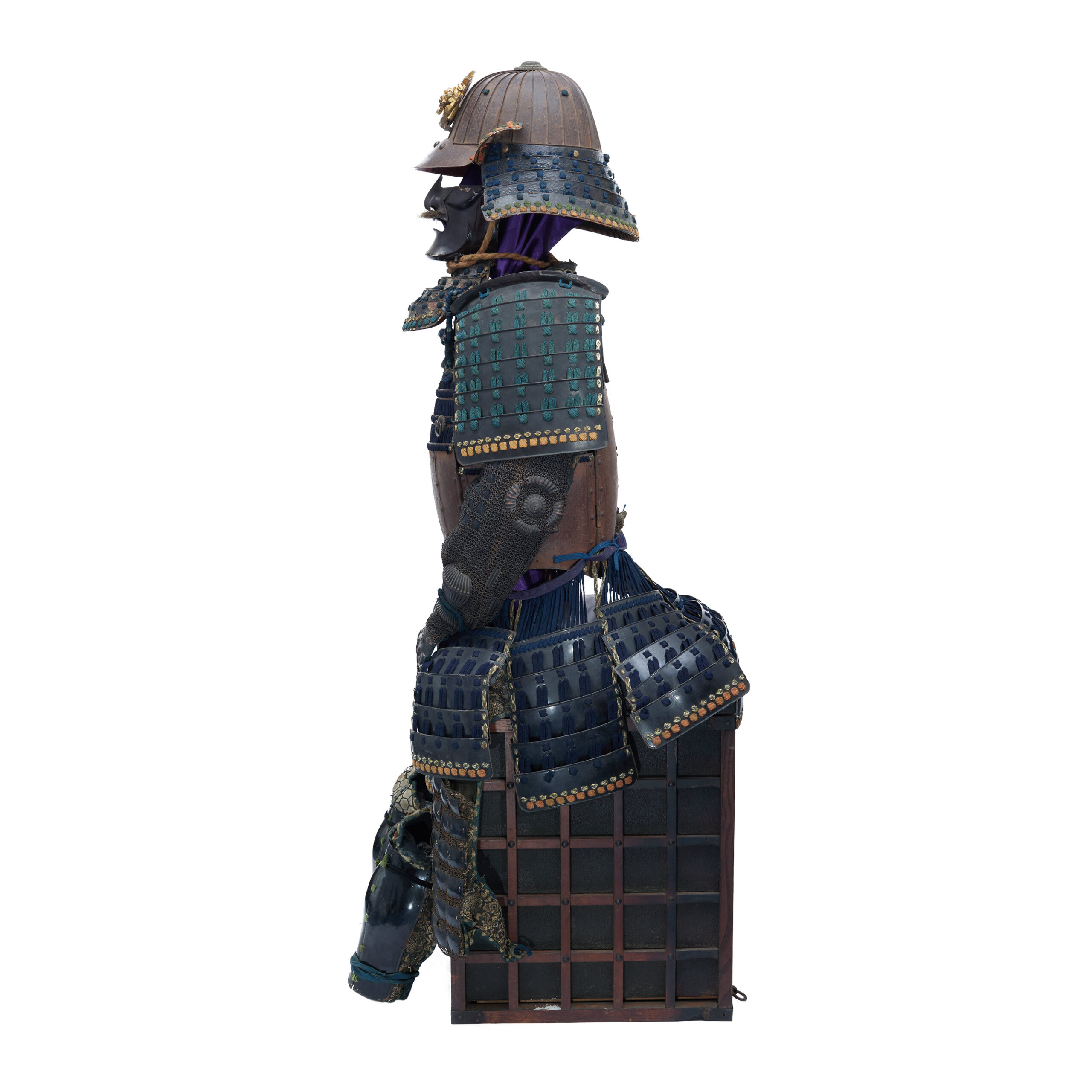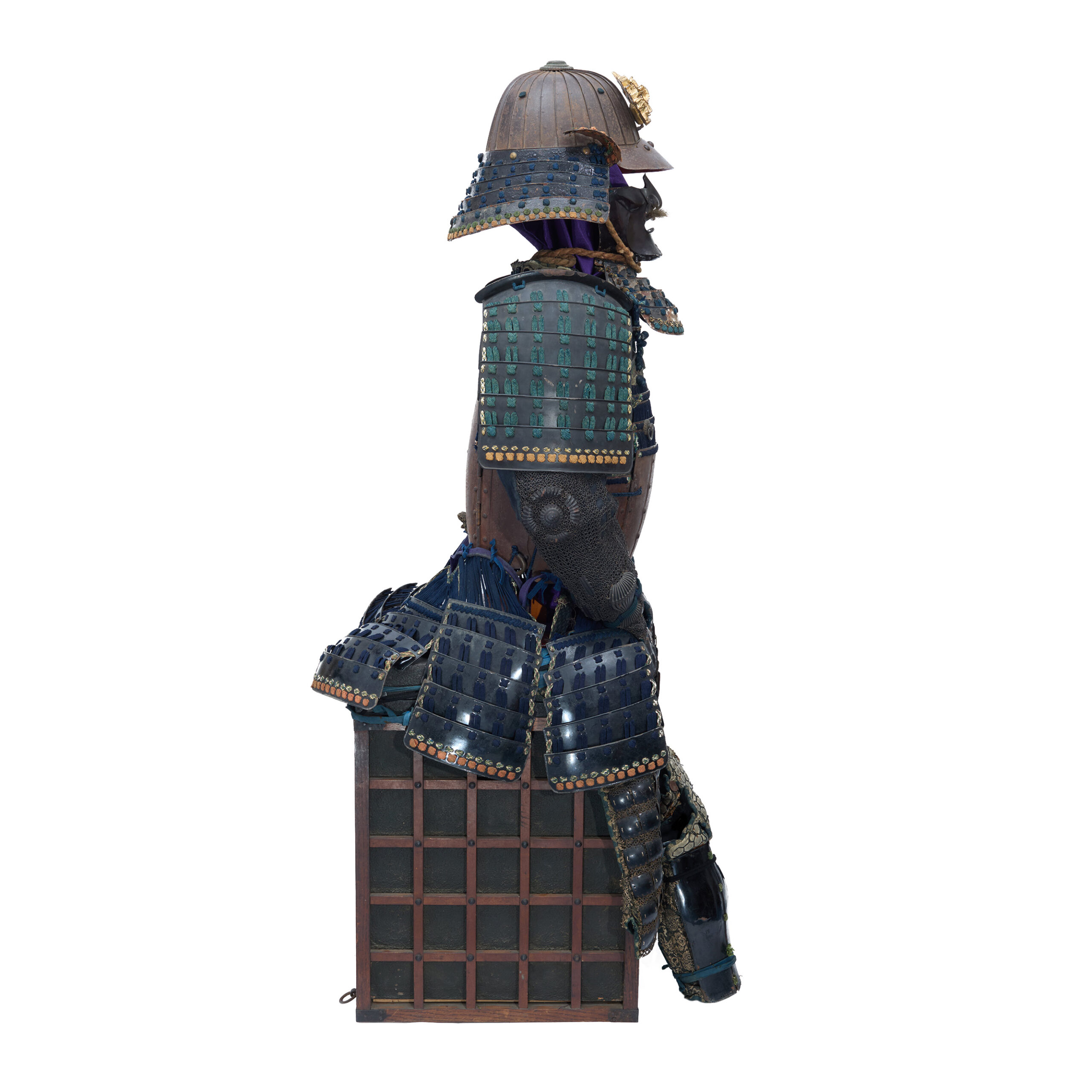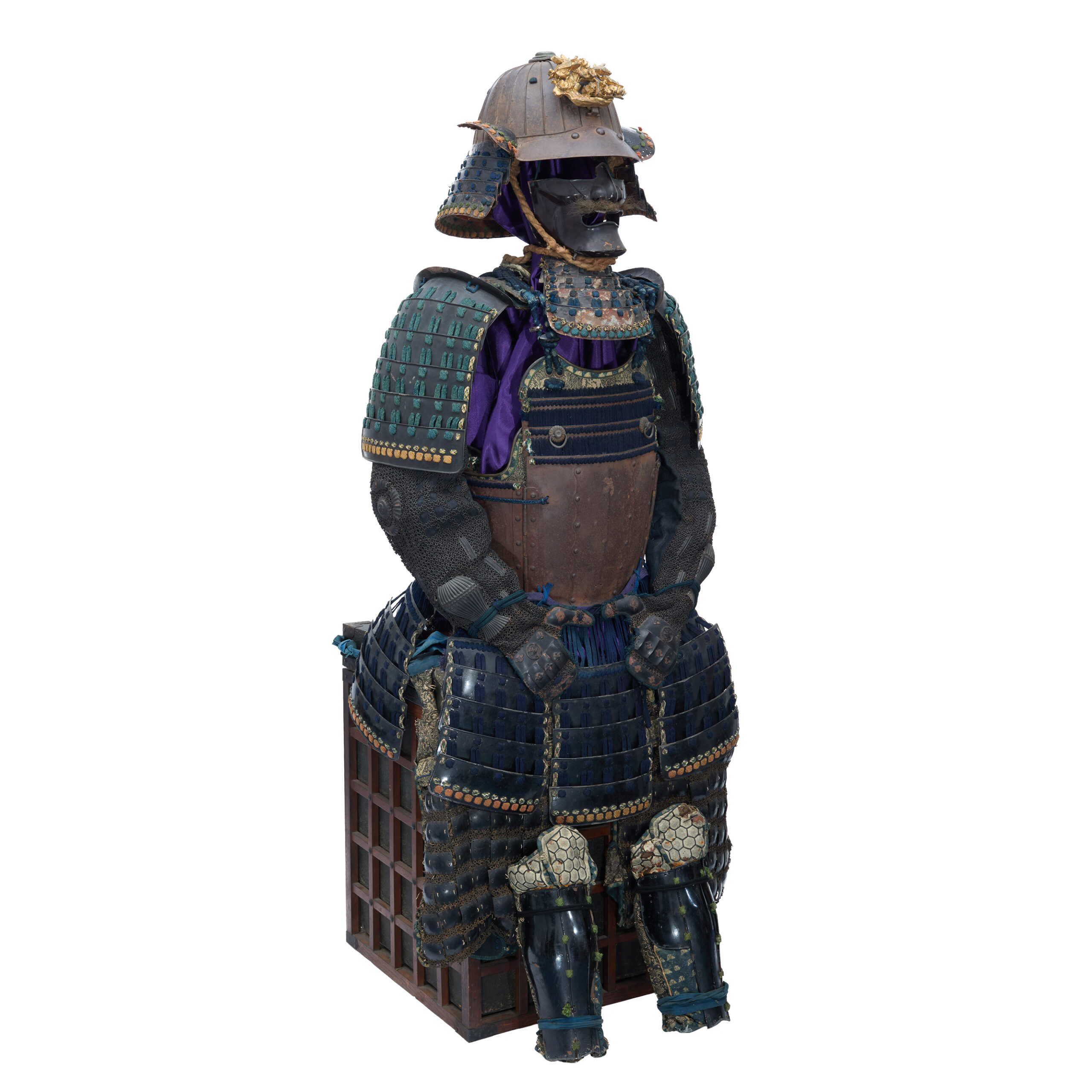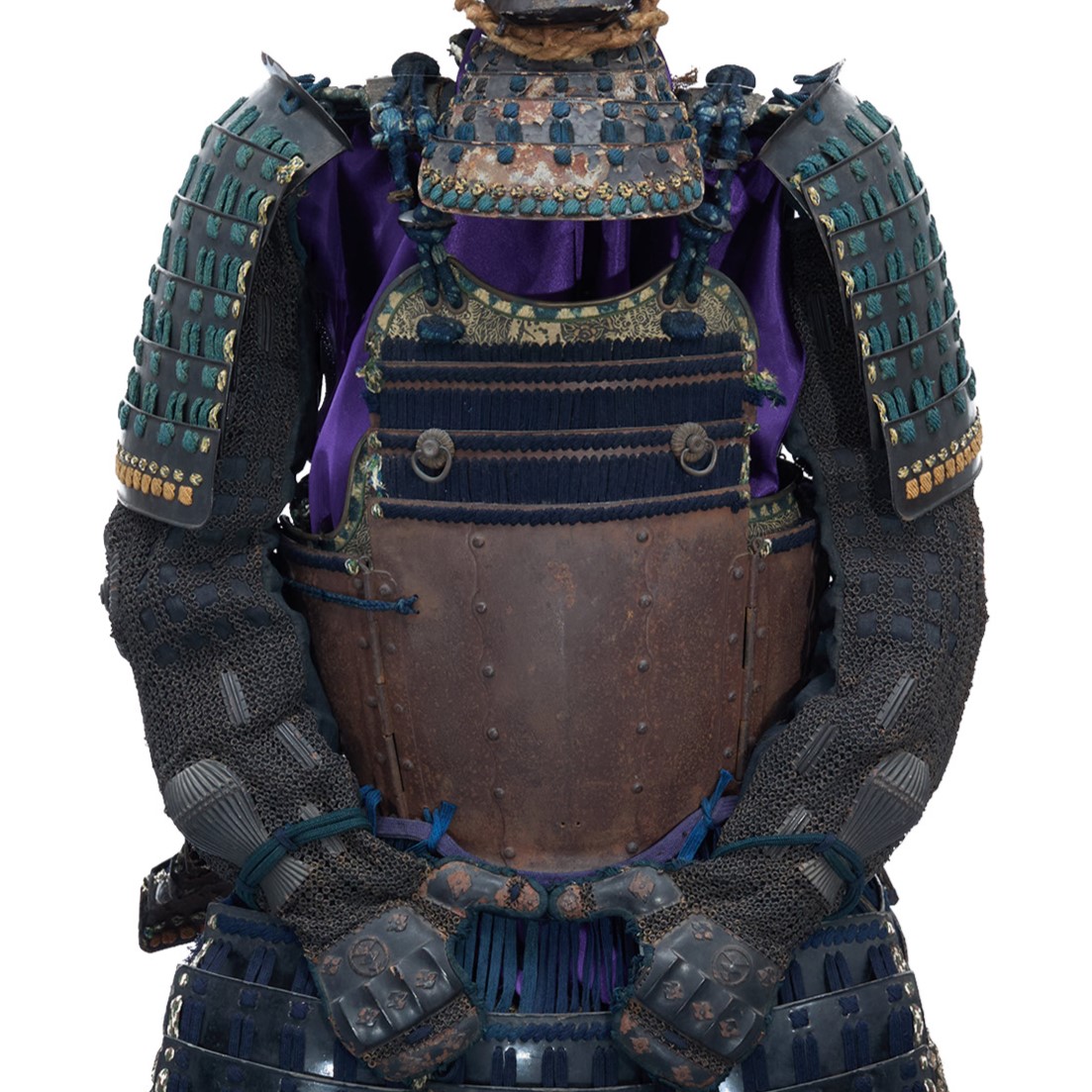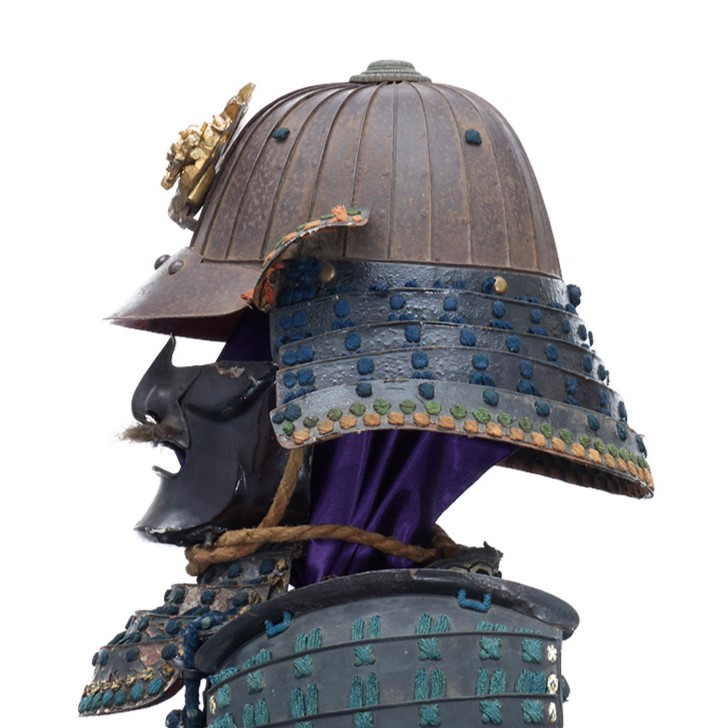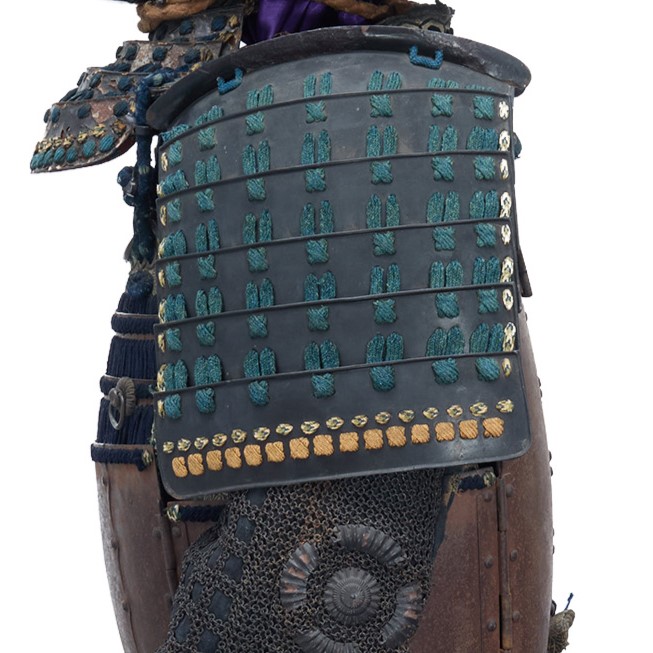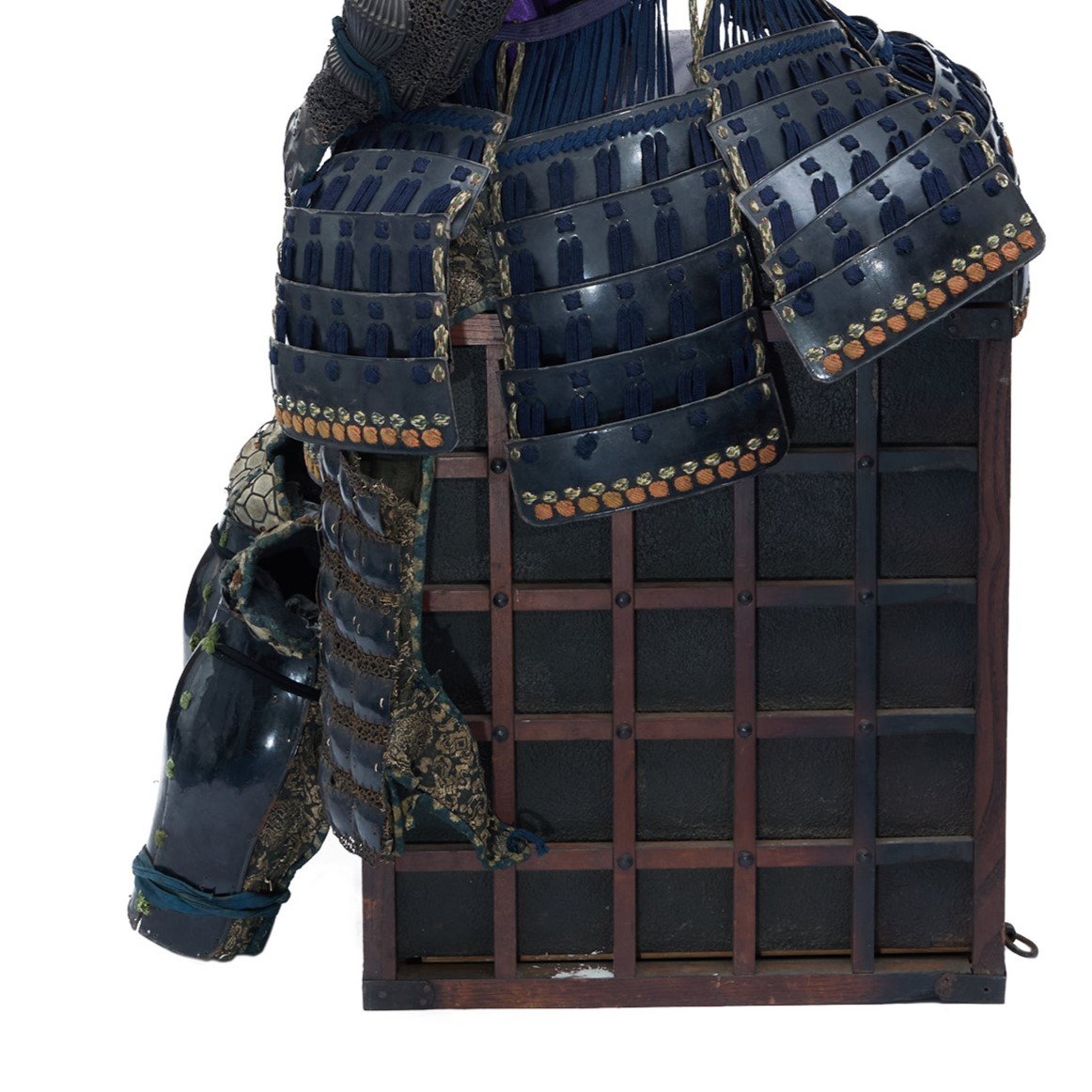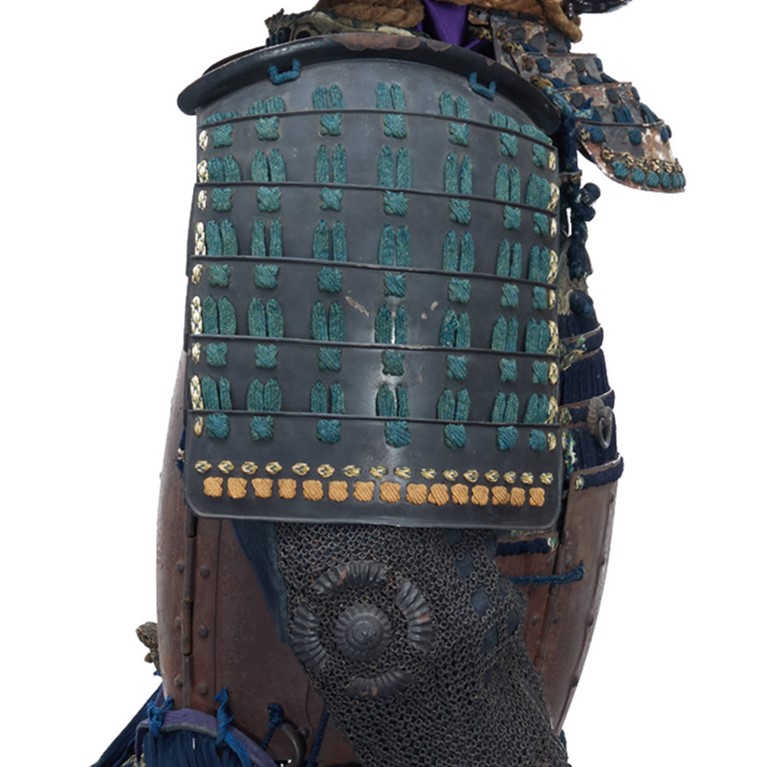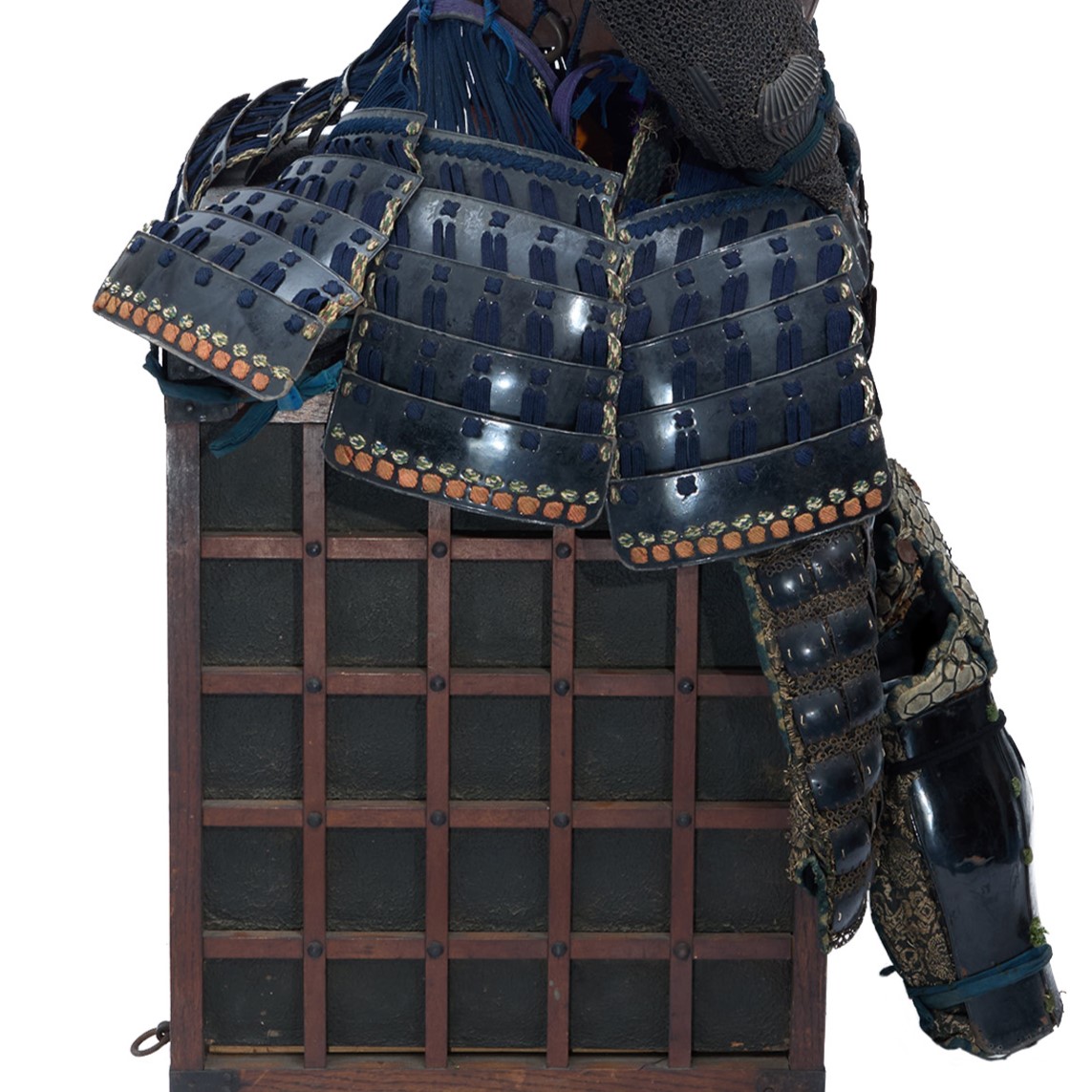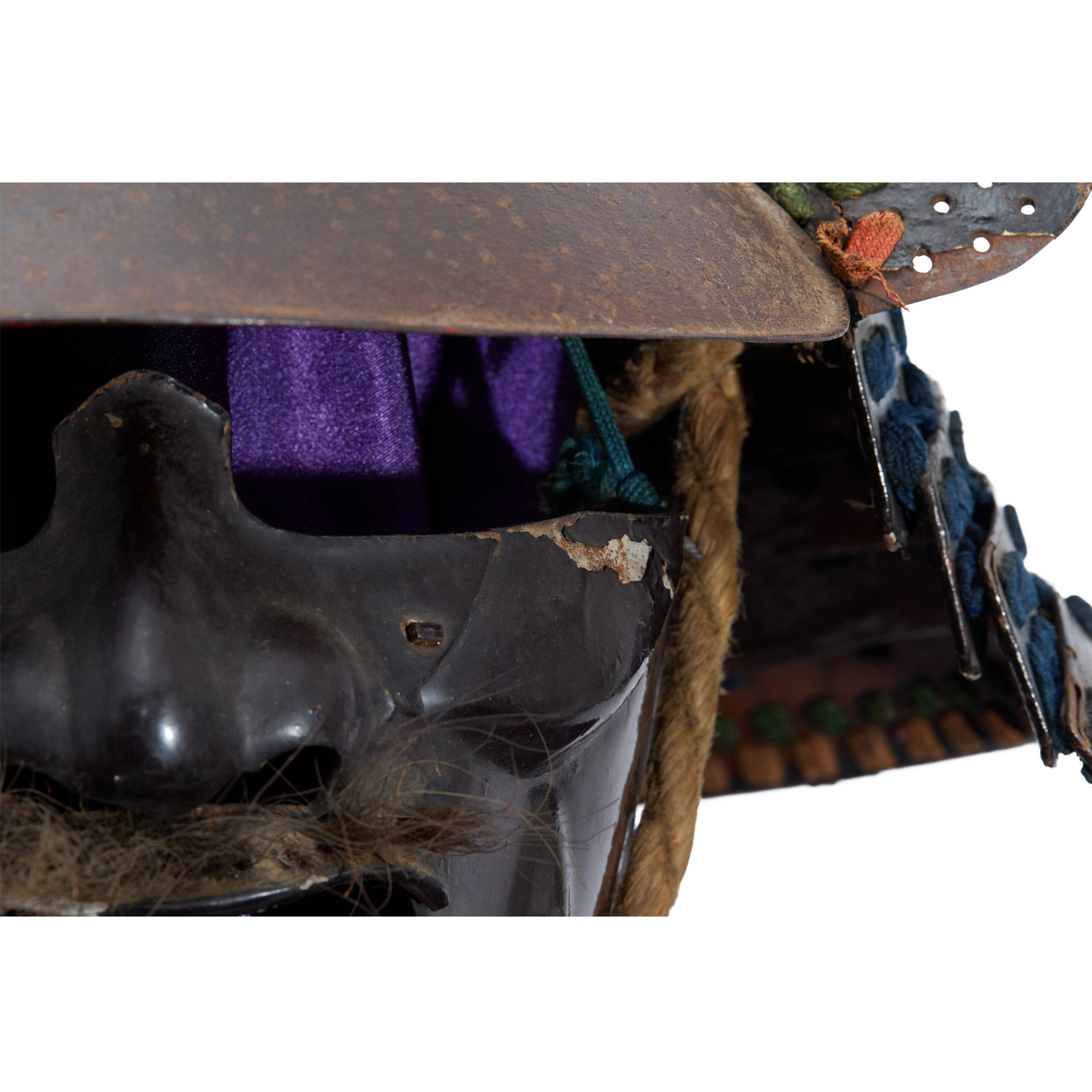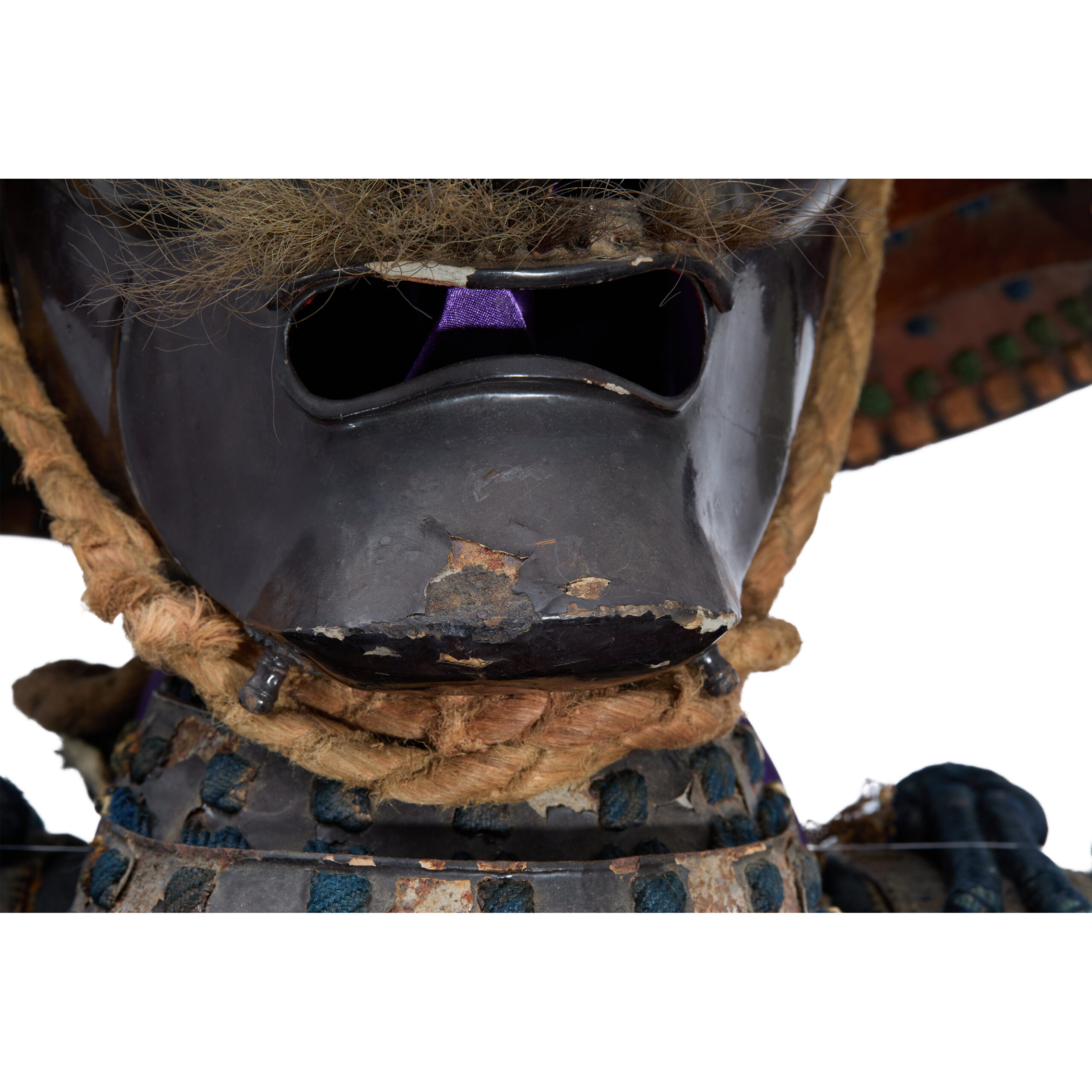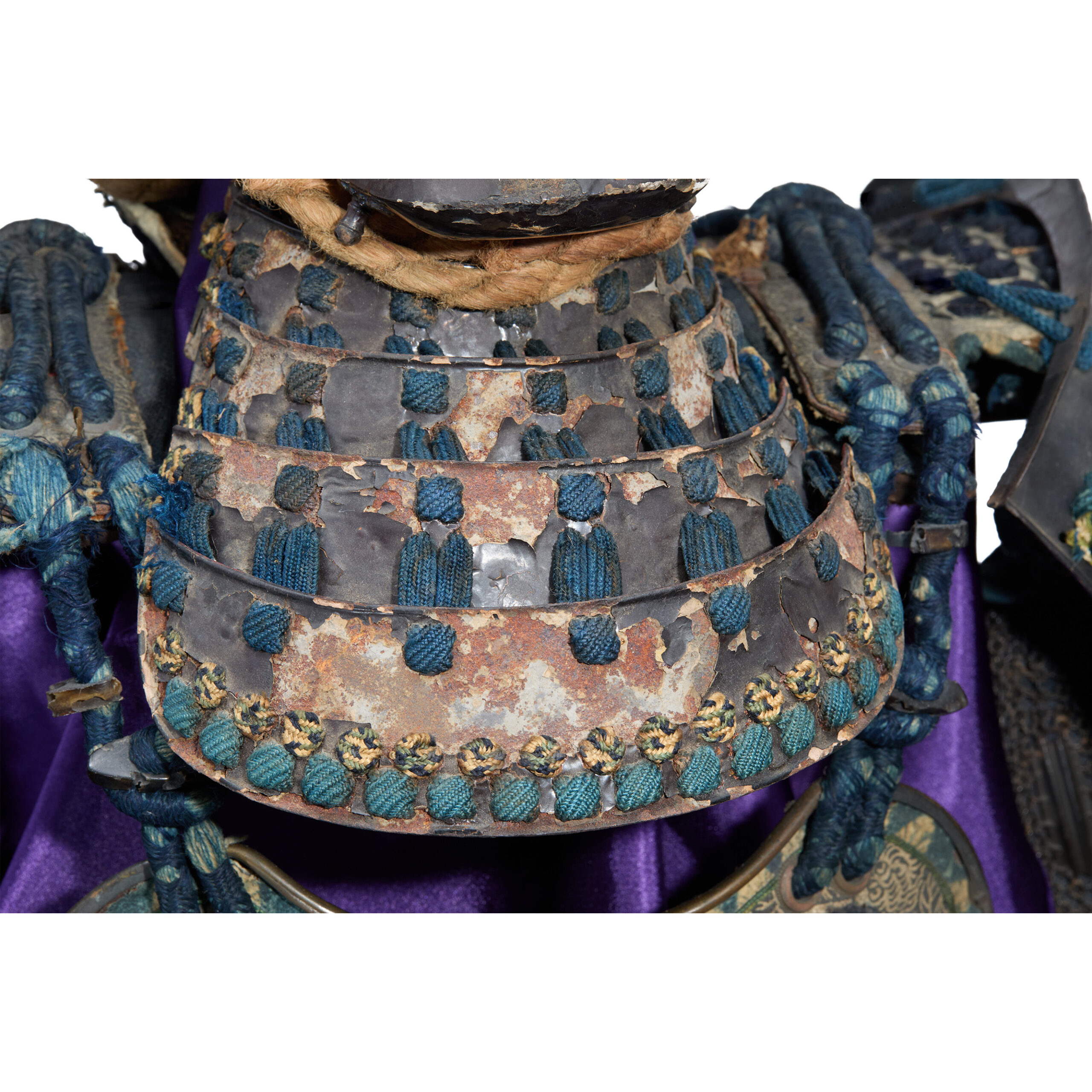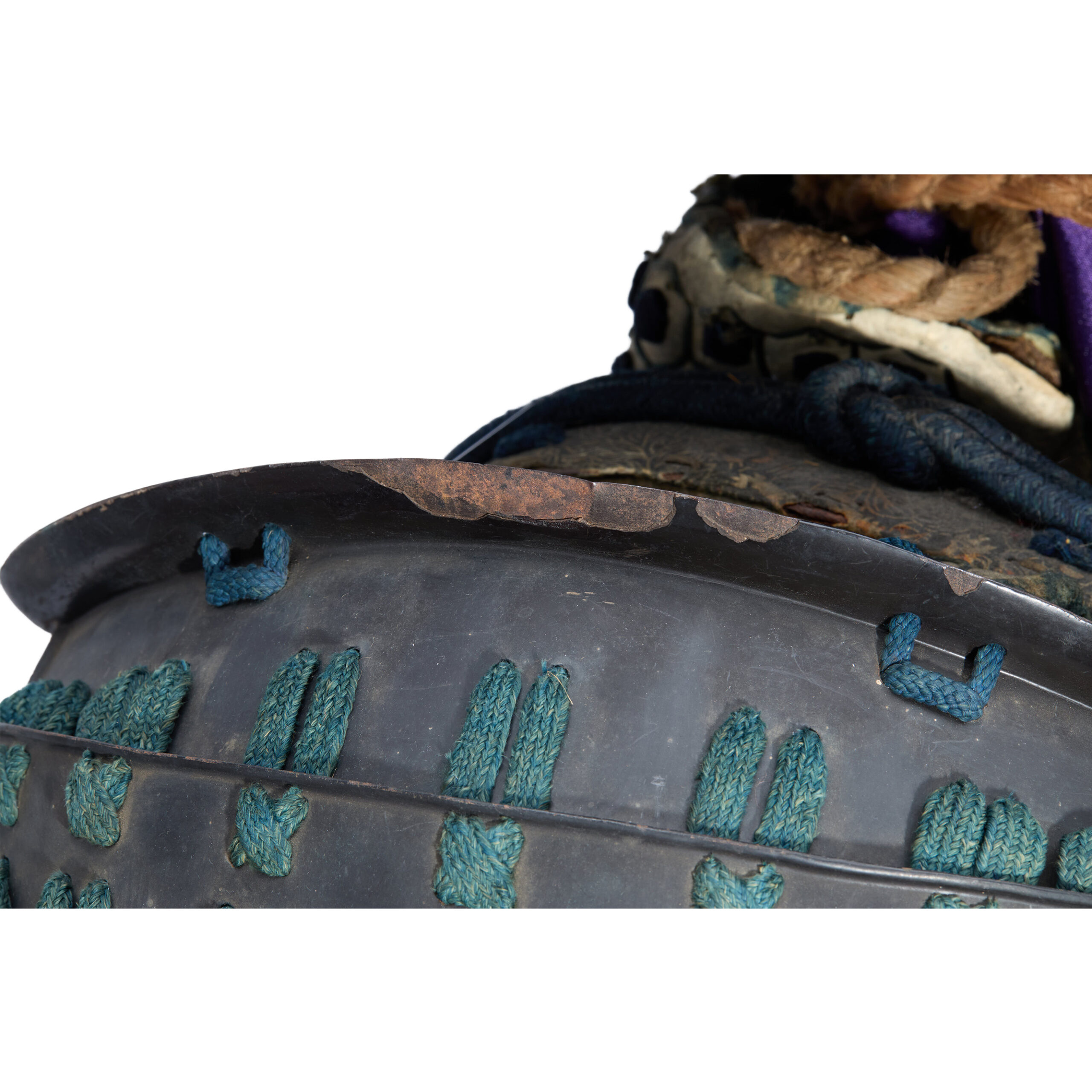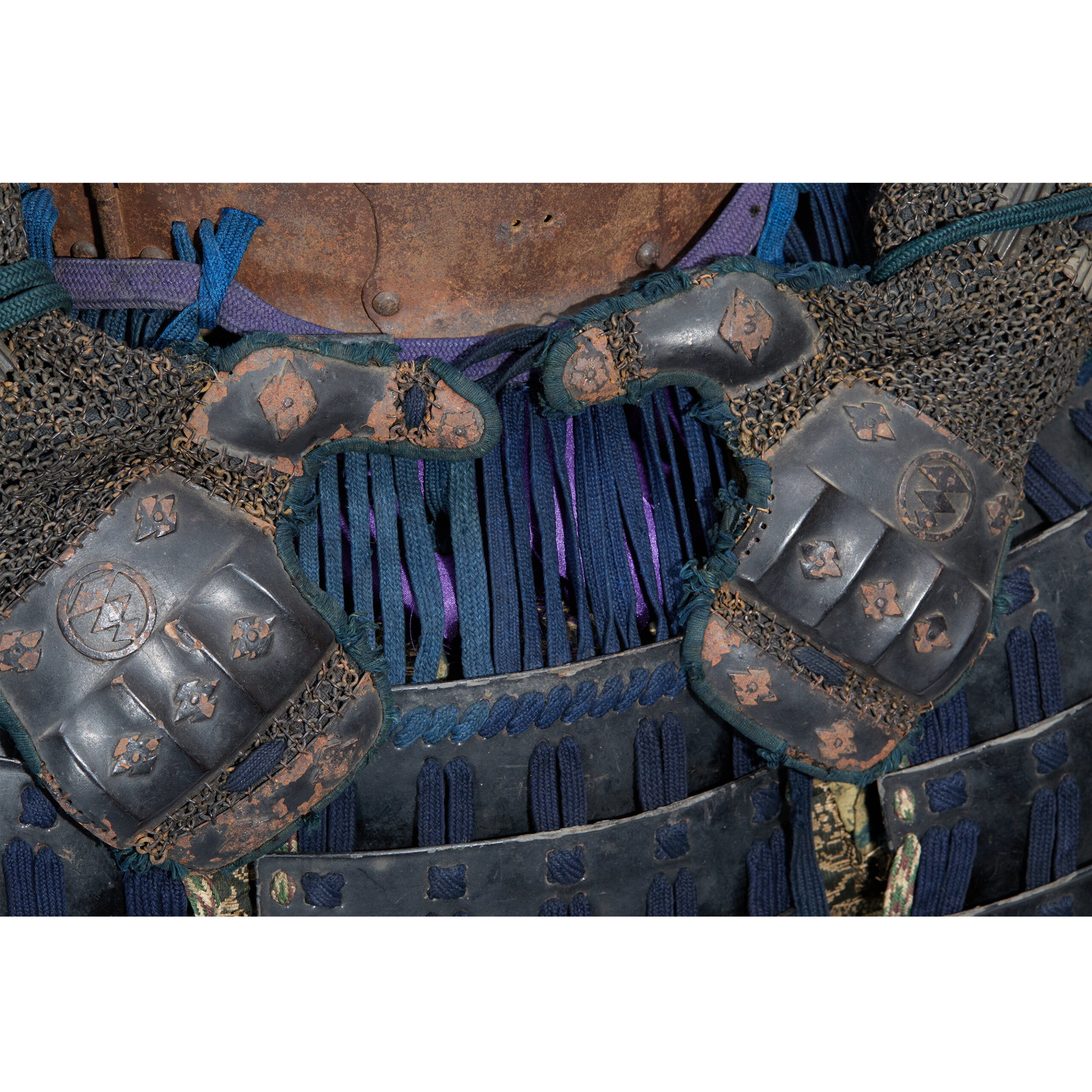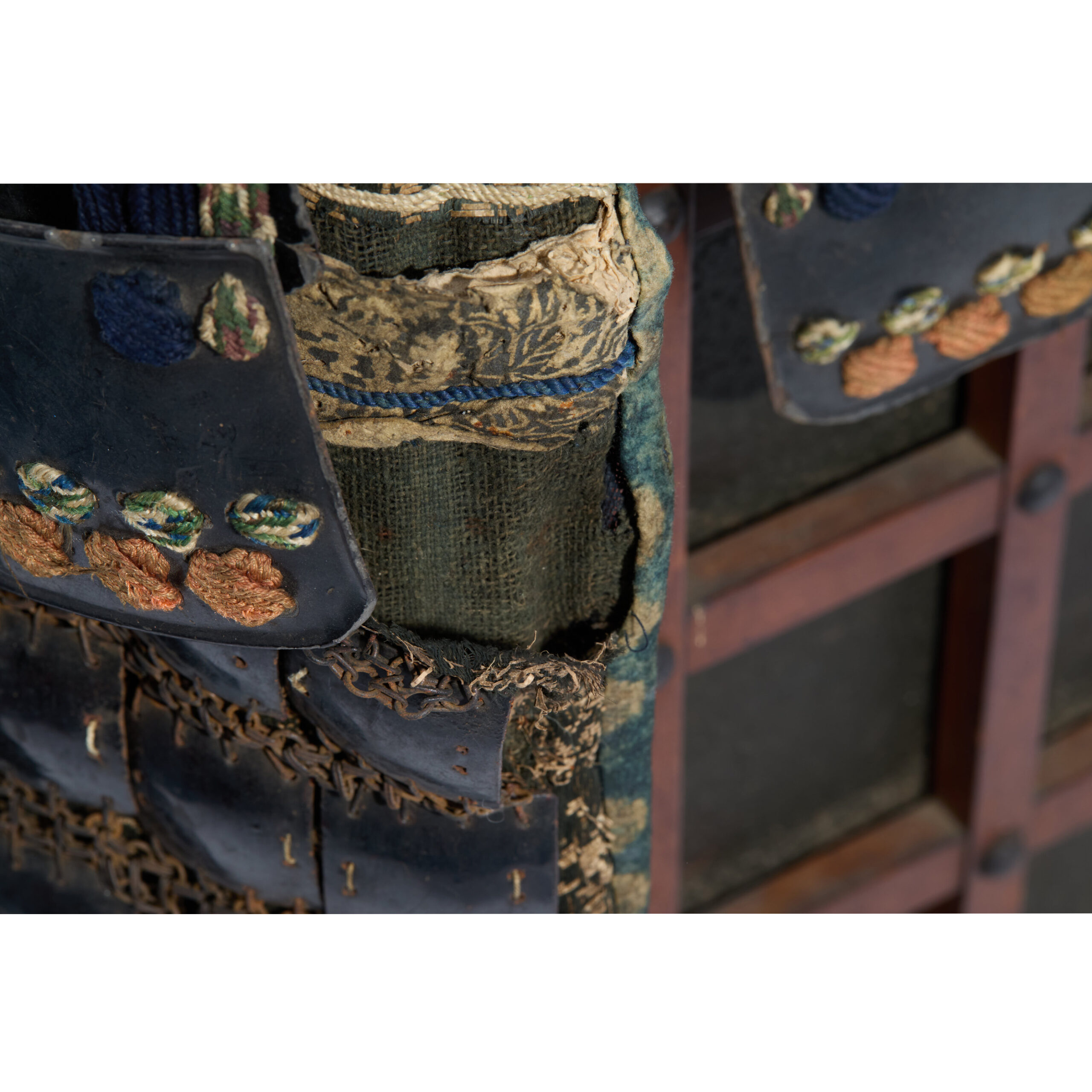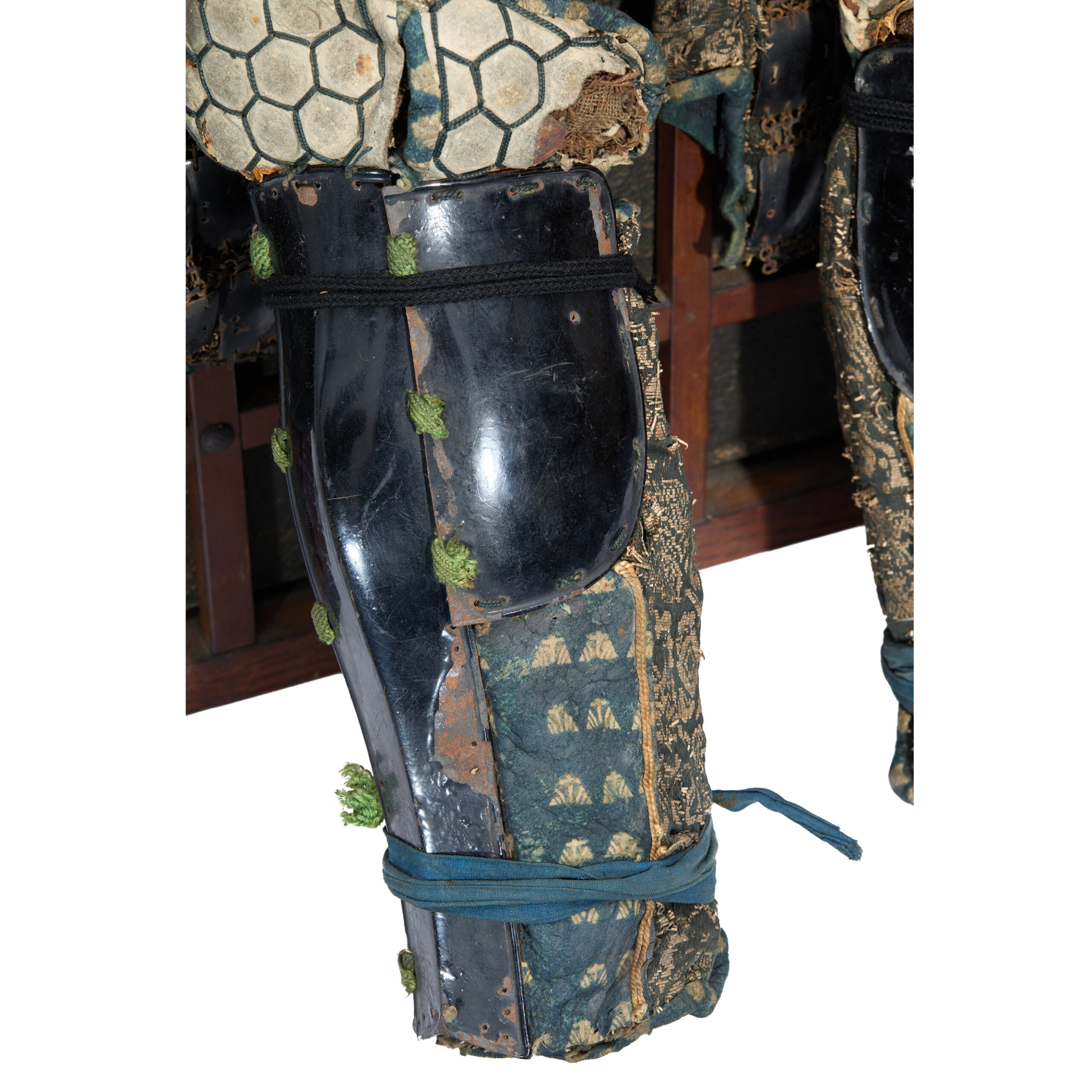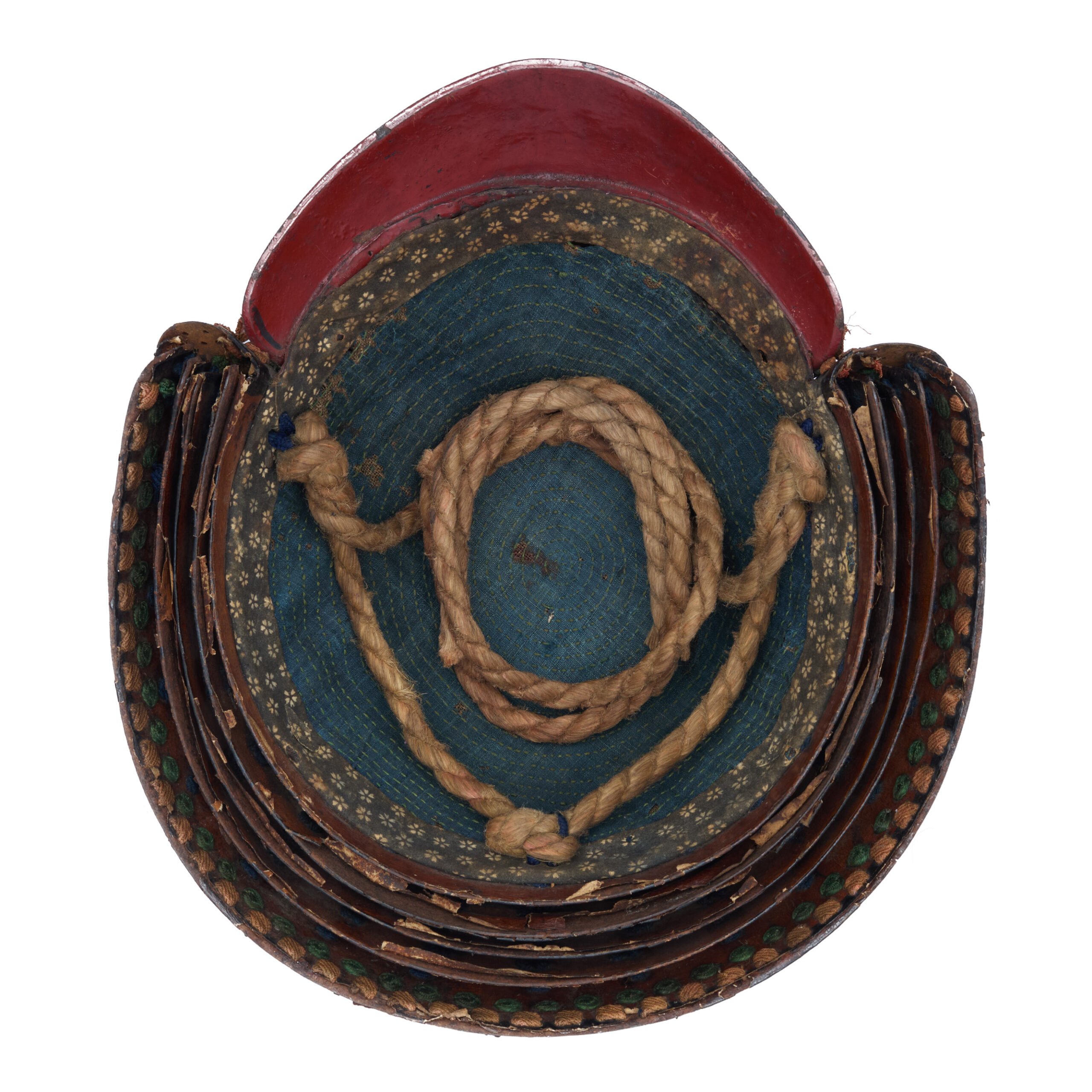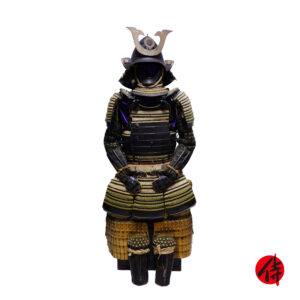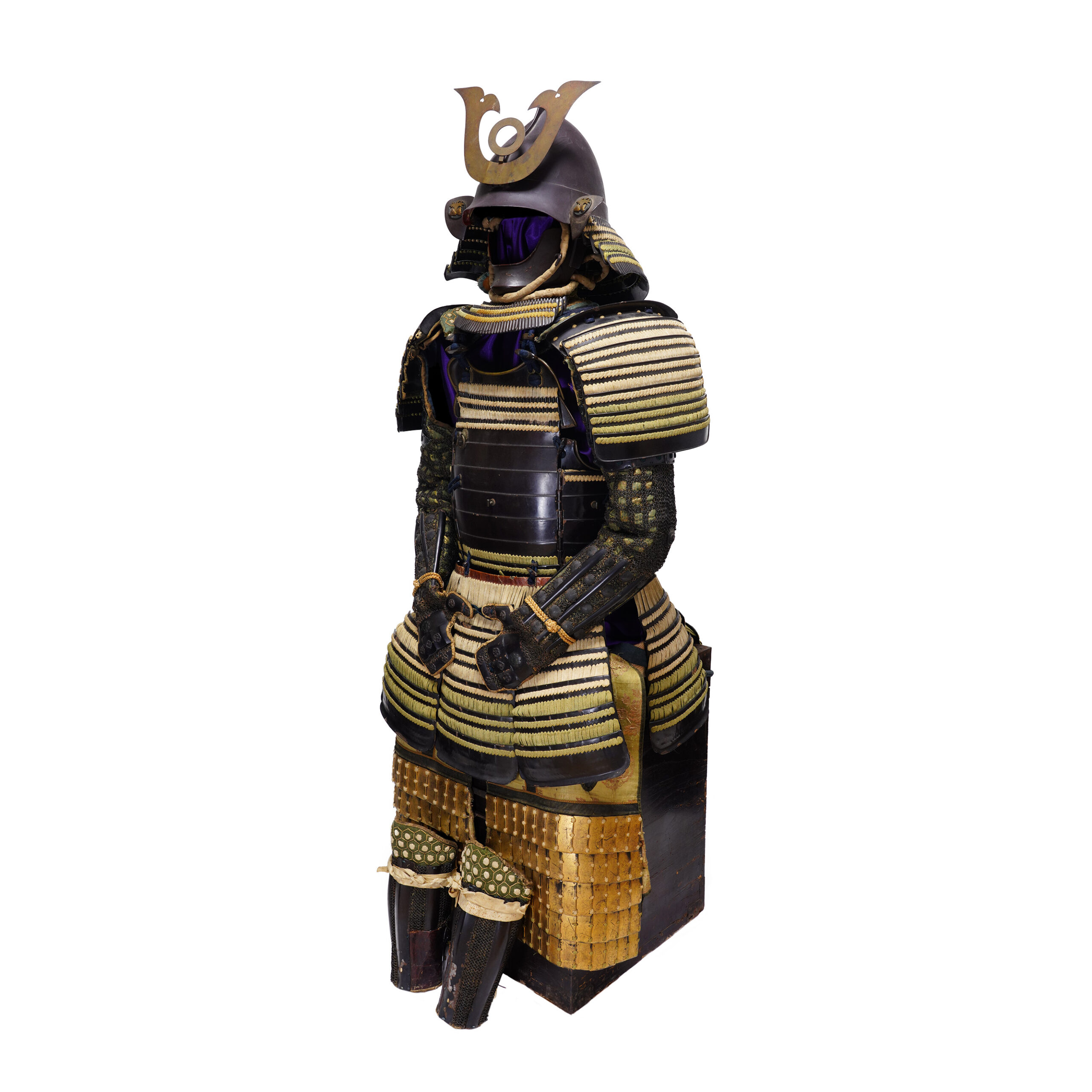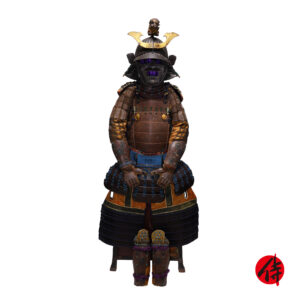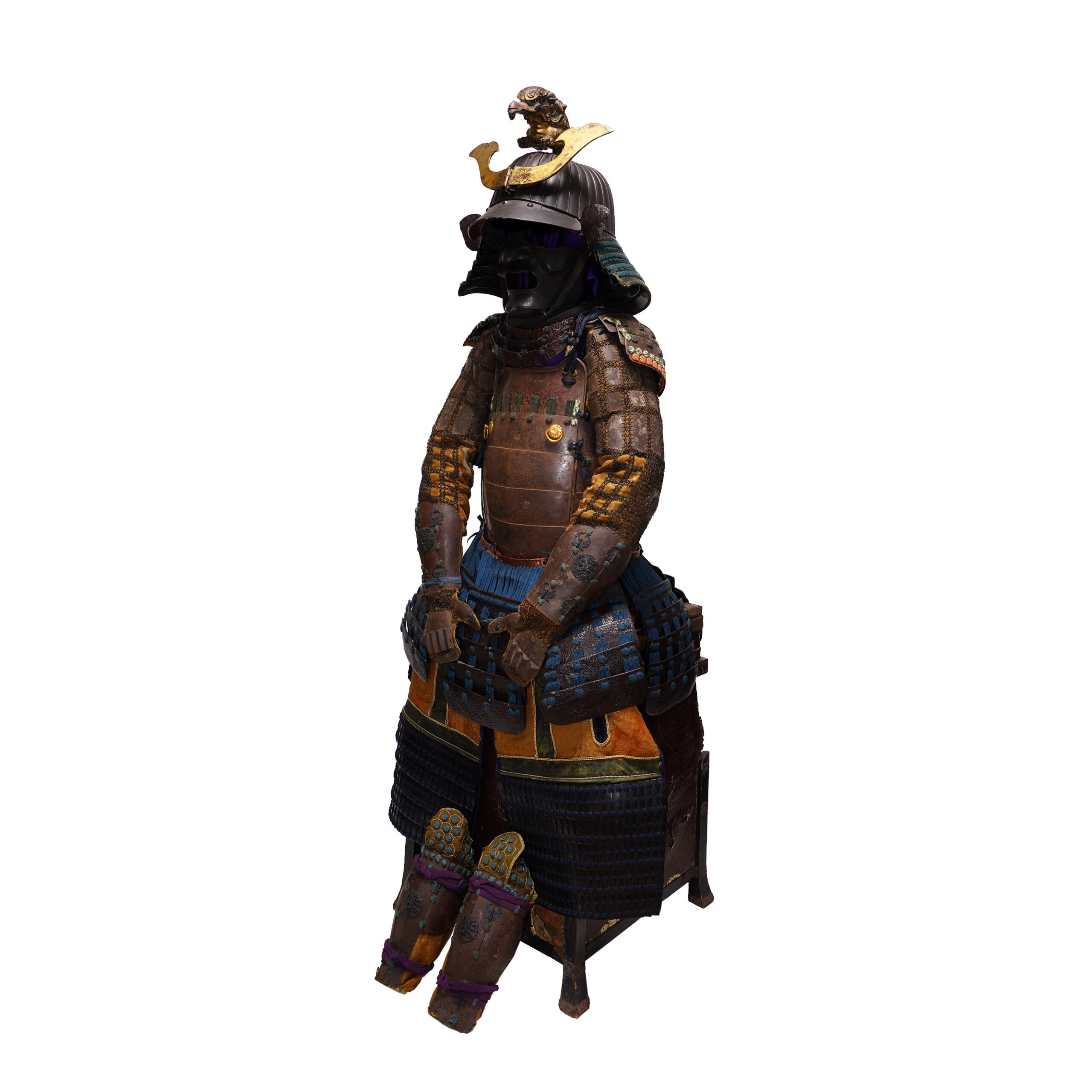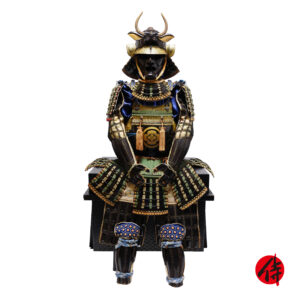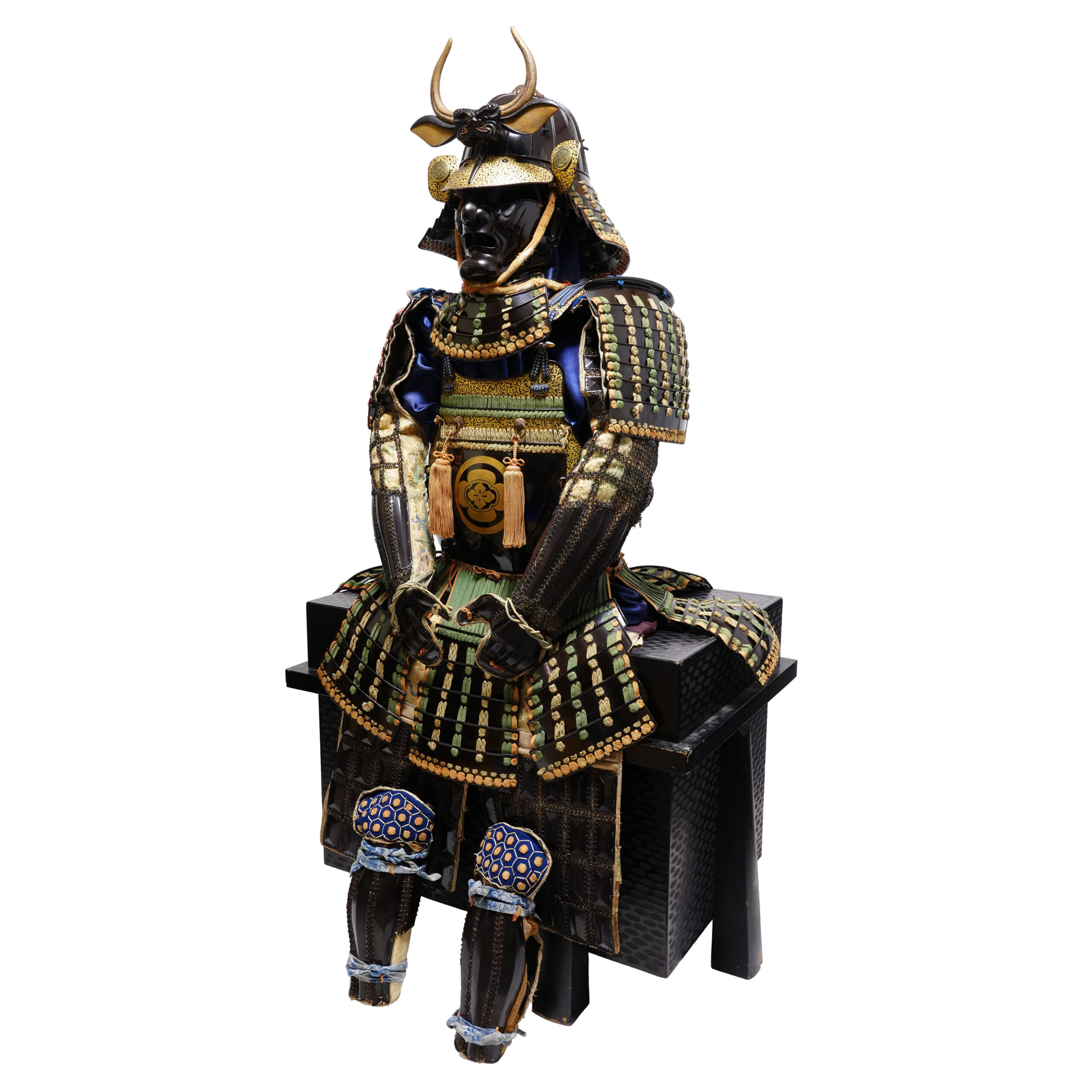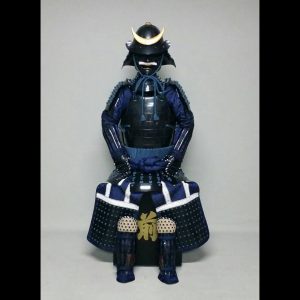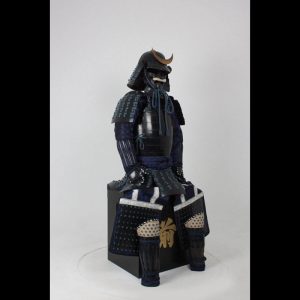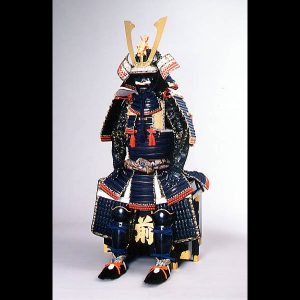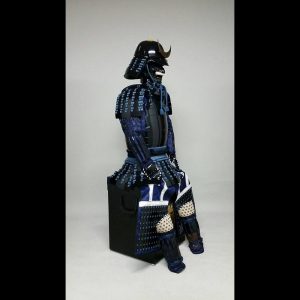Antique Mid Edo Period Samurai Armor Tokubetsu Kicho Shiryo Certificate (A-31)
Period: Mid Edo Period
appraised by The Association for the Research and Preservation of Japanese Helmets and Armor

Kabuto (helmet)
■Helmet bowl: Suji Kabuto
The Kabuto (兜, helmet) is a protector for the head. When people started using the Kabuto, it was initially designed for practical use. However, the principal purpose of its design has changed with time; Samurai warriors tried to express their dignity, personality, or religion by wearing the characteristic designed Kabutos. According to a theory, these uniquely designed Kabutos were made from the late Muromachi (室町後期, 1467-1573) to the Edo period (江戸, 1603-1868). This type of Kabuto is categorized as the Kawari Kabuto (変わり兜), and a variety of materials were used to create them. For example, animal fur, seashells, plants, and paper were used as materials for decoration.
Here we would like to introduce to you a little bit more about the history of Kabutos. Before the Kawari Kabuto’s production, the Suji Kabuto (筋兜) appeared during the Nanbokuchou (南北朝, 1337-1392) period. At that time, the tactic was gradually changed from the piggyback fight style to battle with the Tachi (太刀) sword and the Naginata (薙刀, Japanese halberd) on the ground. Therefore, there was a rise in demand for the weight-saving of the Kabuto. Also, in order to turn the attack by swords, a new type of structure was invented: the Suji Kabuto (筋兜). Its form slides swords’ attacks when weapons hit the Kabuto. It is said that the production of the Suji Kabuto prospered in the Muromachi (室町, 1336-1573) period. We estimate this Kabuto is one of these Suji Kabutos made in that tendency in the Edo period. It has 25 stripes in this Kabuto, meaning 25 small iron plates are connected. It is called Nijugo Ken Suji Kabuto (二十五間筋兜). Niju Go means 25 in Japanese.

■Shikoro (side neck guard):
Iron plates laced with green and vermillion threads.
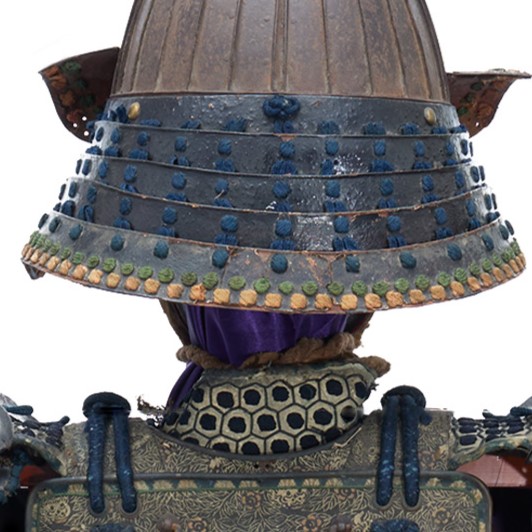
■Fukikaeshi (side neck guard)
The Fukikaeshi (吹き返し) is both ends of a Kabuto. It protects the face from swords.
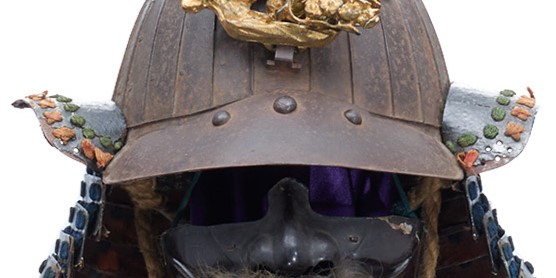
■Menpo (face guard): Ressei Menpo
This type of Menpo is called the Ressei Menpo (烈勢面頬). It represents the angry face to intimidate enemies. There are many types of Menpo, depending on their shape or appearance. The purpose of Menpo was not only to protect Samurai’s face. But also to hide their true faces so that their psychological states were unaffected. Long beards are attached to this Menpo. Thanks to this effect, even a young soldier would have been able to produce the majestic appearance of a middle-aged Samurai.
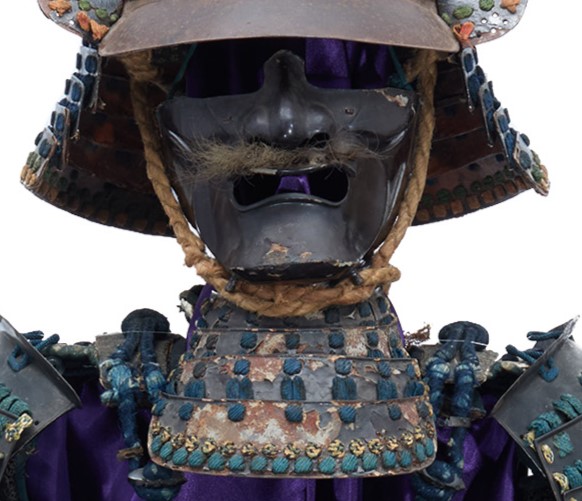
■ Maedate (front decoration): Ume ni Uguisu
The Maedatemono (前立物, front decoration) is attached to this Kabuto. You would find flying birds and the branches of a tree. We estimate the motif is Ume ni Uguisu (梅に鶯). It is a combination of Japanese apricot blossom and Japanese bush warbler. In Japanese poetries and paintings, it is a traditional analogy of a perfect match, a match made in heaven, or a good friendship.
There are several views about the origin of this word. According to a theory, this combination comes from the behavior of Japanese bush warblers. This bird likes the nectar of Japanese apricot blossoms, so it comes to a Japanese apricot tree and cries. However, it is actually the Mejiro (メジロ, Japanese white-eye) who prefers this nectar, not the Japanese bush warbler. Another theory says this combination was born because combining these motifs makes an elegant design. The bush warbler announces early spring with its beautiful cry. In addition, Japanese apricot blossoms bloom beautifully and announce the arrival of spring. It is the idea that this word was born because these combinations were thought to be an attractive design. In the first place, this subject is not native to Japan. It was brought from the continent; the same is true for Japanese apricot blossoms. It is said that nobles once began to use this theme out of their admiration for the continent.

Armor
■Dō (cuirass): Gomai Dō
Gomai Dō is a kind of cuirass for Tousei Gusoku (当世具足, developed armor style). Gomai Dō (五枚胴) was named after the fact that Gomai (五枚) means five plates and Dō (胴) means torso in Japanese. Instead of using a large number of small lamellar plates called Kozane (小札), this cuirass used large iron plates riveted.
Also, the cuirass has iron plate joints, which is called Tate-hagi (縦矧, vertical fletching).
If you look at the cuirass closely, you would find flower-shaped metal fittings. The motif seems to be a chrysanthemum (菊, Kiku). The chrysanthemum is one of the flowers that symbolizes fall, and people appreciate it very much since ancient times. It is said that this flower was used as a medicine for obtaining a long life in China a long time ago, and it was brought to Japan with this thought in the Nara period (648-781). As its petals form radially, the chrysanthemum has been likened to the sun. That is why this flower pattern is treated as the symbol of perpetual youth and longevity or good health. “Kiku no Gomon (菊の御紋)” is a kind of chrysanthemum pattern, and it has been used as the crest of the Emperor and the royal family in Japan so that it is well-known as a noble pattern.

■Kusazuri (skirt of plates attached to the cuirass):
Lacquered iron Kusazuri laced with navy, vermillion, and white threads. The cords for the Odoshi (縅, a technique for armor tying boards together with cords such as leather or thread) are relatively in good condition, so each plate is tied without coming off.

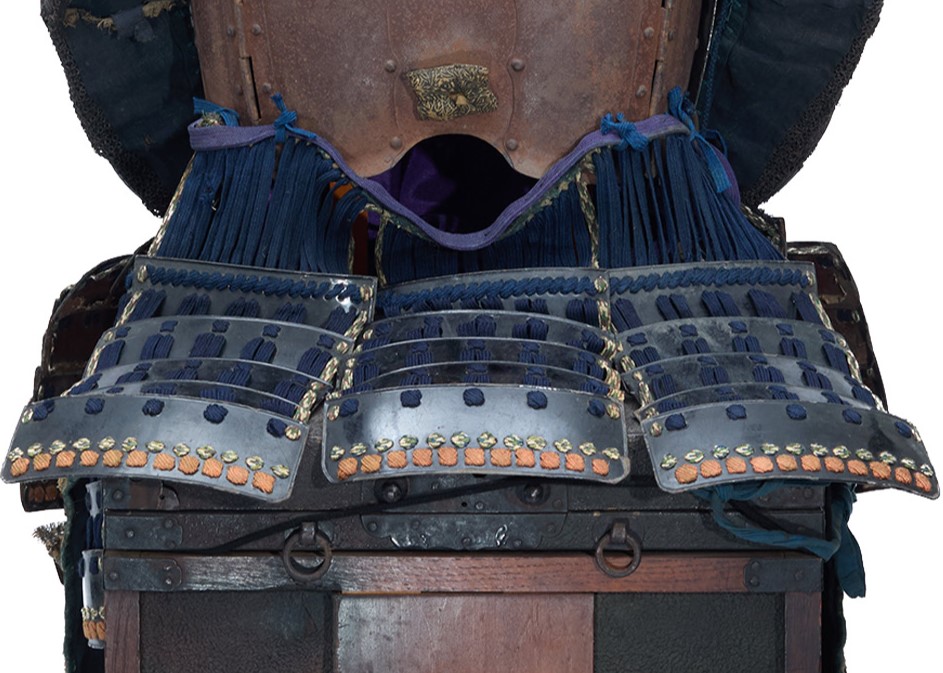
Small parts
■Kote (armored sleeves):
Intricate iron chain mail with silk.
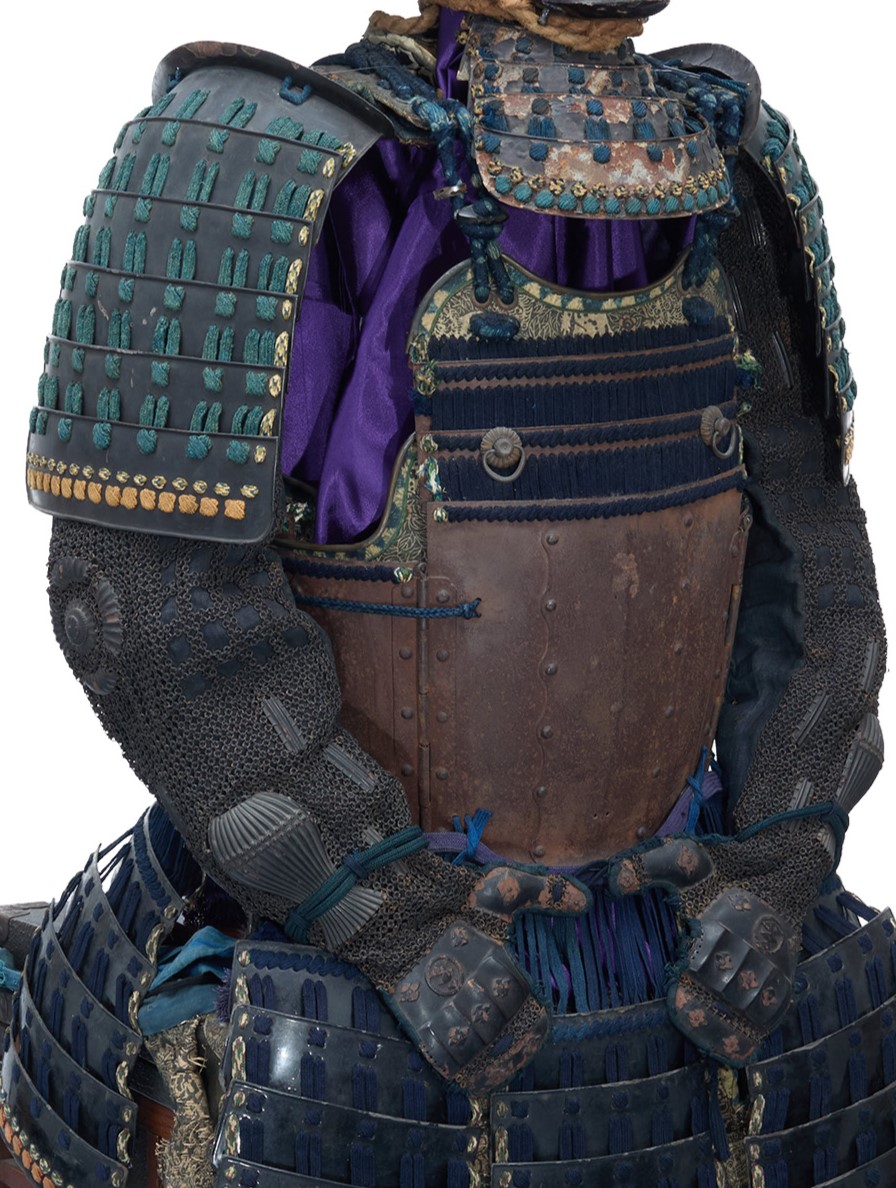

■Haidate (thigh protection):
The Haidate (佩楯) is a thigh guard. Chain mail and iron plates are attached to its cloth.
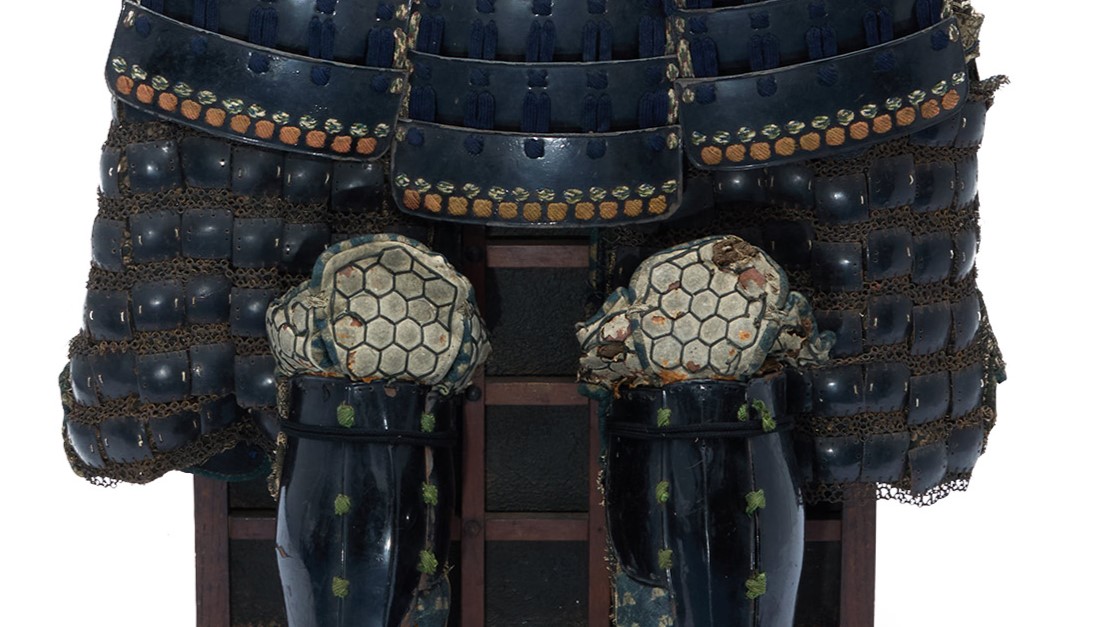

■Suneate (shin guard):
The Kikkou (亀甲, turtle’s shell) pattern is used for the cloth of the Suneate (脛当). It is a continuous geometric pattern connecting regular hexagons up and down. A theory says that this design was brought from China and the Korean Peninsula during the Asuka (飛鳥, 592-710) and Nara (奈良, 710-794) periods. A proverb says turtles live long lives; therefore, turtle and turtle shell patterns represent longevity. In addition, as this continuous hexagonal pattern does not get out of its shape, it is said people wished for eternal prosperity by using this design.
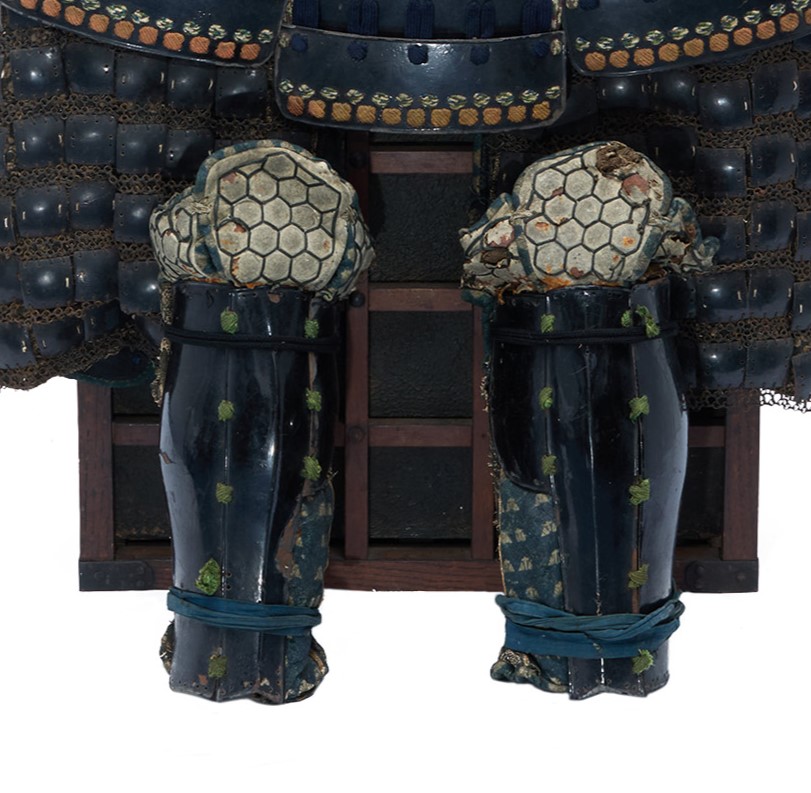
■Gattari (Sashimono holder):
If you focus on the back of this armor, you will find that a square-shaped metal frame is attached. It is a gear called the Gattari (合当理) that supports the upper part of the Sashimono (指物, a frag or decorative sign installed at the back of armor). Samurai warriors judged their sides and enemies on the battlefields by checking the motifs designed for flags. Especially in group battles with infantry, this method was very effective because they could instantly identify affiliations.
*We would also like you to keep in mind that the right side of the thread on the back of the body armor is torn and we tie the part with rope to stay horizontally. There will be no issue to display the armor.

Certification: Tokubetsu Kicho Shiryo Certificate
On December 8th 2024, this armor was appraised as a Tokubetsu Kicho Shiryo by The Association for the Research and Preservation of Japanese Helmets and Armor, which is the most trusted Japanese armor appraiser in Japan. This association is also known as Nihon Katchu Bugu Kenkyu Hozonkai (日本甲冑武具研究保存会). Tokubestu Kicho Shiryo (特別貴重資料) means special rare article. It is ranked as the third highest of five rankings. We are expecting to receive this certificate by February or March 2025.
The paper mentions the armor was made in the mid Edo period (mid 17th-mid 18th). You can receive this original authentication paper.
An English translation of the certificate is available on request. We won’t charge any additional fee.
【About us】
Samurai Museum is located in Tokyo, Japan, exhibiting antique artifacts related to the Samurai history. Samurai Museum Shop is the place for those who are interested in Japanese culture and craftsmanship. We deal with antique Samurai swords/armor, traditional crafts made in Japan and so on.
【Antique Japanese Armor and Export process】
After receiving the full payment from you, we will apply for its export permit from the agency for Cultural Affairs to legally export the antique Samurai armor to other countries. It normally takes around 2-4 weeks to receive this permit. And we would like you to expect at least 1-1.5 months for your order to arrive at your given address after you ordered.
【Payment method】
We accept payment through Stripe (Credit card), PayPal, Apple Pay or ChromePay, all of which are secure payment methods. Also, you don’t need to make an account on Stripe for the checkout. If you prefer other payment method, please contact us. You may either pay in JPY, USD, AUD, CAD, EUR, CHF or GBP. The price is set in Japanese Yen. Prices in other currencies are automatically calculated based on the latest exchange rate.

【Shipping duration】
We normally ship via EMS (Express Mail Service) provided by Japan Post. It usually takes at least 5-14 days to deliver the package after you place an order. We offer Free International Shipping as long as we can ship your order by EMS. If you prefer other shipping carriers, please contact us.
We will inform you of the order’s tracking number via email. Please make sure you fill out your valid email address correctly.

【How to make sure the condition】
Please keep in mind that what you are going to purchase is an antique item. We uploaded high resolution photos for you to check its condition thoroughly. If you like to see more photos with different angles, please feel free to contact us. We will be happy to send them to you so that you can make informed decision. It is essential for us to know that you are happy with your choice of a sword. and we are prepared to use the best of our ability to serve you.
【How To Contact Us】
Please contact us through email, Facebook Messenger or Live Chat if you have any questions. You can find each icon on the right side of the website. Please click one of them to reach us. We will reply to you within 1-2 business days.
【How To Preserve Antique Samurai Armor】
Dryness, humidity, and bad ventilation might deteriorate the condition of antique Samurai armor. The best temperature to preserve Samurai armor is around 20℃ in Celsius, and humidity should be about 60%. Direct sunlight should be avoided. We recommend storing armors in a room with good ventilation. If you like to display them outside the boxes for a prolonged time, we suggest using a glass case in order for dust not to be accumulated easily. In case you don’t use a glass case, please make sure to regularly dust off from the armor by using a soft brush made of delicate cloth or brush for painting.
If you like to know more about the preservation of this armor, please feel free to contact us.


